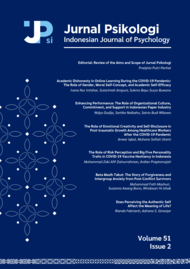RTs across Dual Stimuli, Gender, GPA and Trialt-ype
Hartanto Hartanto(1*)
(1) Widya Dharma University
(*) Corresponding Author
Abstract
Keywords
Full Text:
PDFReferences
Adam JJ, Paas FG, Buekers MJ, Wuyts IJ, Spijkers WA, Wallmeyer P. (1999). Gender diOEerences in choice reaction time: evidence for differential strategies. Ergonomics, 1999, 42(2), 327- 335.
Atmaca, S. Sebanz, N. & Knoblich, G. (2011). The joint flanker effect: sharing tasks with real and imagined co-actors. Exp Brain Res, 211, 371–385. doi: 10.1007/s00221-011-2709-9
Anderson, B. (2014). Computational Neuroscience and Cognivite Modelling. SAGE Publications Inc.
Bernard J. B. Chung S. T. L. (2011). The dependence of crowding on flanker complexity and target-flanker complexity. Journal of Vision, 11(8), 1–16.
Baars,B,J. & Gage,N,M. (2013). Fundamentals of cognitive neuroscience : a beginner’s guide. 2013 Elsevier Inc. All rights reserved.
Bugg, J, M. (2014). The relative attractiveness of distractors and targets affects the coming and going of item-specific control: Evidence from flanker tasks. Atten Percept Psychophys, 77, 373–389. doi:10.3758/s13414-014-0752-x.
BBC Horizon. (2014). Is Your Brain Male or Female.http://www.bbc.co.uk/program mes/b04knbny.
Bonnet,C. & Dresp, B. (1993). Methods and Design – A fast procedure for studying conditional accuracy function. Behavior Research Methods, Instruments, & Computers 1993, 25, 2-8.
Blais, C. Stefanidi, A. & Brewer, G,A. (2014). The Gratton effect remains after controlling for contingencies and stimulus repetitions. Frotier in Psychology, 05, 1-11. doi: 10.3389/fpsyg.2014.01207
Carreiras, M. Quinones, I. Hernandez-Cabrera, J,A. & Dunabeitia, J, A. (2015). Orthographic Coding: Brain Activation for Letters, Symbols, and Digits. Cerebral Cortex, 25(12), 4748–4760.
Chanceaux, M. Mathot, S. & Grainger, J. (2014). Effects of number, complexity, and familiarity of flankers on crowded letter identification. Journal of Vision November 2014, 14(7). doi:10.1167/14.6.7
Chen, C. Yang, J. Lai, J. Li, H. Yuan,J. & Abbasi, N,H. (2015). Correlating Gray Matter Volume with Individual Difference in the Flanker Interference Effect. PLoS ONE, 10(8), doi:10.1371/journal.pone.0136877 .
Dalmaijer, E. S., Mathôt, S., & der Stigchel, S. (2014). PyGaze: An open-source, cross- platform toolbox for minimal-effort programming of eyetracking experiments. Behavior Research Methods, 46(4), 913–921.
Durlack, J. A. (2005). How to Select, Calculate, and Interpret Effect Sizes. Journal of Pediatric Psychology, 34(9), 917–928.
de Fockert, J, W. (2013). Beyond Perceptual Load and Dilution: a review of the role of working memory in selective attention. Frontier in Psychology, 04, 1-12.
Ghinescu, R. Schatchman, T.R. Ramsey, A,K. Gratton, G. Fabiani, M. (2016). Conflict Adaptation and Cue Competition during Learning in an Eriksen Flanker Task. PLoS ONE, 11(12), 1-19. doi:10.1371/journal.pone.0167119
Hazeltine, E. & Mordkoff, J,T. (2014). Resolved but not forgotten: Stroop conflict dredges up the past. Frontier of Psychology, 5(1327), doi: 10.3389/fpsyg.2014.01327
Hartanto. (2016). Pengenalan Analisis Statistik dengan Software R. Magnum Publising, Bantul, Yogyakarta.
Hubner, R. Steinhauser, M. & Lehle, C. (2010). A Dual-Stage Two-Phase Model of Selective Attention. First publ. in: Psychological Review 117 (2010), 3, 759- 784. doi: 10.1037/a0019471
Hubner, R. & Lehle, C. (2007). Strategies of Flanker Coprocessing in Single and Dual Tasks. Journal of Experimental Psychology/Human Perception and Performance 33(1), 103-123
Jain,A. Bansal, R. Kumar,A. & Singh,K,D. (2015). A comparative study of visual and auditory reaction times on the basis of gender and physical activity levels of medical first year students. Int J Appl Basic Med Res. 5(2), 124 – 127. doi:10.4103/2229-516X.157168
Judge, J. Taylor, P, J. (2008). Gender differences on the semantic flanker task using transposed-letter target words. The Quarterly Journal of Experimental Psychology. 65(10). 2008-2017. https://doi.org/10.1080/17470218.2012.67 6654.
Kabacoff, R, I. (2011). R in Action. by Manning Publications Co. Shelter Island, All rights reserved.
Kraus, F. & Lindemann, O. (2014). Expyriment: A Python library for cognitive and neuroscientific experiments. Behav Res (2014), 46, 416–428. doi: 10.3758/s13428- 013-0390-6.
Mayr,U. Awh,E. & Laurey,P. (2003). Conflict adaptation effects in the absence of executive control. Nat, Neurosci. 6, 450– 452. doi:10.1038/nn1051
Mordkoof. (1996). Selective Attention and Internal Constraints: There Is More to the Flanker Effect Than Biased Contingencies.
McLean,S,P. Garza, J,P. Wiebe,S,A. Dodd, M,D. Smith,K,B. Hibbing, J,R. & Espy,K,A. (2013). Applying the Flanker Task to Political Psychology: A Research Note. Political Psychology, Vol. xx, No. xx, 2013. doi: 10.1111/pops.12056
Postle. B,R. (2015). Essentials of cognitive neuroscience. 2015 John Wiley & Sons, Ltd.
Rouder,J,N & King,J,W. (2003). Flanker and negative flanker effects in letter identification. Perception & Psychophysics 2003, 65(2), 287-297
Stins, J, F. Polderman, J,C,T. Boomsma,D,I. & Geus, E,J,C. (2007). Conditional accuracy in response interference tasks: Evidence from the Eriksen flanker task and the spatial conflict task. Advances in Cognitive Psychology. 2007, 3(3), 409-417. doi: 10.2478/v10053- 008-0005-4.
Shiraev, E,B & Levy, D,A. (2010). Cross- Cultural Psychology – Critical Thinking and Contemporary Applications. 2010 Pearson Education, Inc.
Ryan, R. (2009). Self Determination Theory and Wellbeing. Journal of WeD Research Review, 1, 1 – 2.
Wells, I,C. & Hamm, J,P. (2009). The Effect of Inverting Stimuli in a Flanker Task. Canadian Journal of Experimental Psychology, 63(1), 33 – 39. doi: 10.1037/a0013440.
Wright, J, D. (2015). International Encyclopedia of the Social and Behavioral Sciences – Second Edition. 2015 Elsevier Ltd. unless otherwise stated. All rights reserved.
Wylie, S,A, van den Wildenberg, W,P,M. Ridderinkhof, K,R. Bashore, T,R. Powell,V,D. Manning, C,A. & Wooten, G,F. (2009). The effect of speed-accuracy strategy on response interference control in Parkinson’s disease. Neuropsychologia, 47(0), 1844–1853. doi:10.1016/j.neuropsychologia.2009.02.0 25.
Zhou, P. & Liu, X. (2013). Attentional Modulation of Emotional Conflict Processing with Flanker Tasks. PLoS ONE March 2013, 8(3), 1-8 doi:10.1371/ journal.pone.0060548
Zhu, Y. Zhou, Q. & Ye, X,D. (2016). Competing with visible and invisible competitors in flanker tasks. Social behavior and personality, 2016, 44(11), 1815–1824. http://dx.doi.org/10.2224/sbp.2016.44.11. 1815.
https://github.com/marsja
https://www.psychologytoday.com/blog/hope- relationships/201402/brain-differences- between-genders
Article Metrics
Refbacks
- There are currently no refbacks.
Copyright (c) 2018 Jurnal Psikologi

This work is licensed under a Creative Commons Attribution-ShareAlike 4.0 International License.
Recent Issues
 |  |  |  | ||||
| Vol 51 Issue 2 (2024) Page 120-230 | Vol 51 Issue 1 (2024) Page 1-119 | Vol 50 Issue 3 (2023) Page 219-332 | Vol 50 Issue 2 (2023) Page 125-218 |
| Published by Faculty of Psychology, Universitas Gadjah Mada, Indonesia Building D-6th, Floor No. D-606. Jl. Sosio Humaniora No. 1, Bulaksumur Yogyakarta, 55281 Email: jurnalpsikologi@ugm.ac.id Phone/whatsApp: +6281125210175 |











